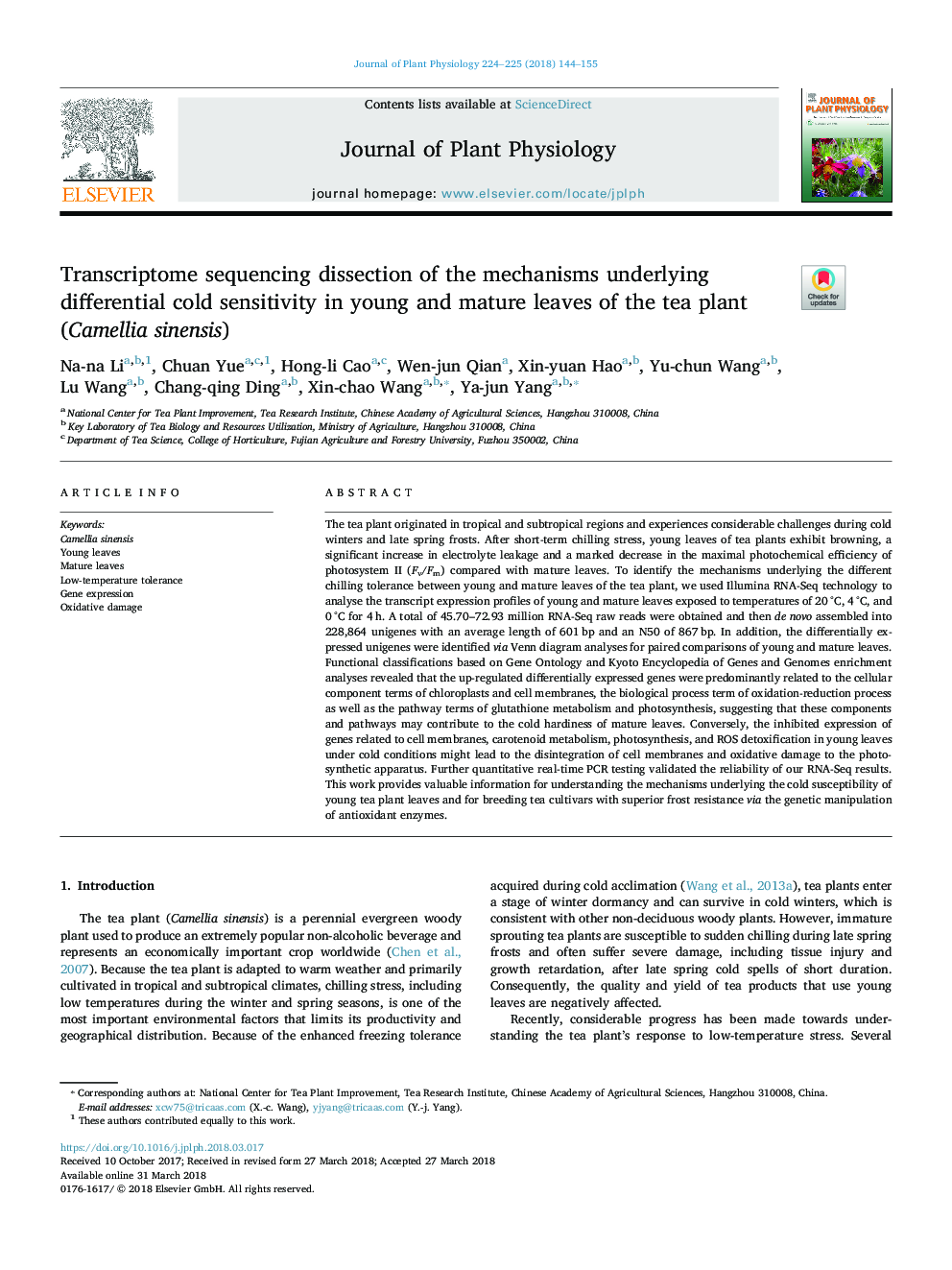| کد مقاله | کد نشریه | سال انتشار | مقاله انگلیسی | نسخه تمام متن |
|---|---|---|---|---|
| 8386857 | 1543854 | 2018 | 12 صفحه PDF | دانلود رایگان |
عنوان انگلیسی مقاله ISI
Transcriptome sequencing dissection of the mechanisms underlying differential cold sensitivity in young and mature leaves of the tea plant (Camellia sinensis)
دانلود مقاله + سفارش ترجمه
دانلود مقاله ISI انگلیسی
رایگان برای ایرانیان
کلمات کلیدی
موضوعات مرتبط
علوم زیستی و بیوفناوری
علوم کشاورزی و بیولوژیک
علوم زراعت و اصلاح نباتات
پیش نمایش صفحه اول مقاله

چکیده انگلیسی
The tea plant originated in tropical and subtropical regions and experiences considerable challenges during cold winters and late spring frosts. After short-term chilling stress, young leaves of tea plants exhibit browning, a significant increase in electrolyte leakage and a marked decrease in the maximal photochemical efficiency of photosystem II (Fv/Fm) compared with mature leaves. To identify the mechanisms underlying the different chilling tolerance between young and mature leaves of the tea plant, we used Illumina RNA-Seq technology to analyse the transcript expression profiles of young and mature leaves exposed to temperatures of 20â¯Â°C, 4â¯Â°C, and 0â¯Â°C for 4â¯h. A total of 45.70-72.93 million RNA-Seq raw reads were obtained and then de novo assembled into 228,864 unigenes with an average length of 601â¯bp and an N50 of 867â¯bp. In addition, the differentially expressed unigenes were identified via Venn diagram analyses for paired comparisons of young and mature leaves. Functional classifications based on Gene Ontology and Kyoto Encyclopedia of Genes and Genomes enrichment analyses revealed that the up-regulated differentially expressed genes were predominantly related to the cellular component terms of chloroplasts and cell membranes, the biological process term of oxidation-reduction process as well as the pathway terms of glutathione metabolism and photosynthesis, suggesting that these components and pathways may contribute to the cold hardiness of mature leaves. Conversely, the inhibited expression of genes related to cell membranes, carotenoid metabolism, photosynthesis, and ROS detoxification in young leaves under cold conditions might lead to the disintegration of cell membranes and oxidative damage to the photosynthetic apparatus. Further quantitative real-time PCR testing validated the reliability of our RNA-Seq results. This work provides valuable information for understanding the mechanisms underlying the cold susceptibility of young tea plant leaves and for breeding tea cultivars with superior frost resistance via the genetic manipulation of antioxidant enzymes.
ناشر
Database: Elsevier - ScienceDirect (ساینس دایرکت)
Journal: Journal of Plant Physiology - Volumes 224â225, MayâJune 2018, Pages 144-155
Journal: Journal of Plant Physiology - Volumes 224â225, MayâJune 2018, Pages 144-155
نویسندگان
Na-na Li, Chuan Yue, Hong-li Cao, Wen-jun Qian, Xin-yuan Hao, Yu-chun Wang, Lu Wang, Chang-qing Ding, Xin-chao Wang, Ya-jun Yang,